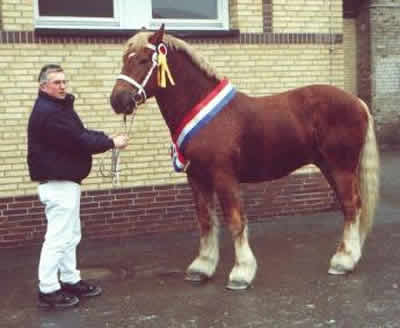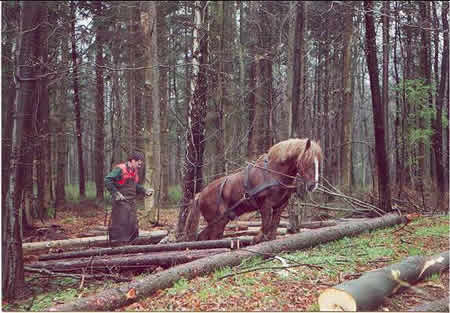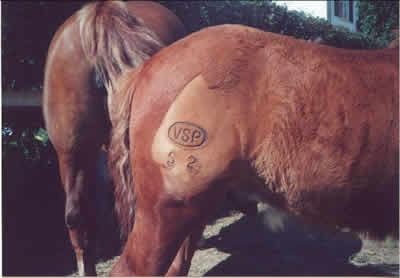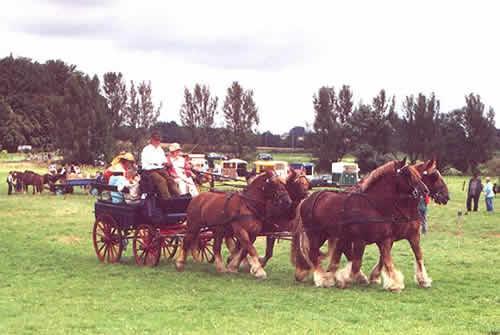Schleswiger Heavy Draft
Introduction
The Schleswiger Heavy Draft originates from the north of Germany. It is
of middle size and weight and was influenced especially by the introduction
of the Jutland Heavy Draft and other heavy horse breeds. Until the sixties
the Schleswiger served as a working horse. Nowadays it is on the list
of the endangered domestic animal breeds from the society for the protection
of old domestic animal breeds. (GEH, http://www.g-e-h.de/geh-raku/pferde/pferschl.htm)
Description of the breed
The Schleswiger Heavy Draft is of middle size and weight. It stands at
approximately 154 - 162 cm. The stallions are an average bigger than the
mares.

The 3 year old price winning stallion of the year 2003 (Photo: Bernd Lühr
)
The legs are strong and dry, lightly feathered. The round hooves are of
a good quality. The back should be short and well muscled. The head is
short and straight with a broad forehead. The neck should be well proportioned.
The Schleswiger is usually chestnut colour seldom though, black, grey
and bay occur. The Schleswiger is an excellent mover with an astounding
walk and trot.
The Schleswiger has a good placid character an is very willing to learn.
Versatile and agile and of great endurance, easy to keep and feeding problems
are virtually unknown to this breed.

Hard work in the wood: Th. Isenberg hauling timber with the stallion Konsul
in the "Rantzauer Forst" (Photo: R. Welzel).
History
In 1888 the earlier breeders association of Schleswig Holstein decided
to separate the breeding of warm-blood and heavy horses. In 1891 the Schleswiger
Horse Breeders Society was founded. The brandmark with the letters "V.S.P"
in an oval, that still today is used to brand the horses on the right
back leg.

The brandmark with the letters "V.S.P" in an oval, that still
today is used to brand the horses on the right back leg. (Photo: Bernd
Lühr )
Through the introduction of different breeds, Oldenburger, Holstein and
Suffolk Punch the desired results in breeding couldn't be fulfilled. In
1862 Jutland stallions were imported. Since 1930 virtually all Schleswiger
are related to the "Oppenheim" (Shire or Suffolk Punch) son
"Munkedal".
The height of popularity was reached in 1949. In the Studbook there were
approximately 25.000 mares and 450 stallions registered.
Owing to the progress in agriculture and the usage of machinery the Schleswiger
as all German heavy horse breeds suffered. In 1976 the breed reached an
all time low - only 35 mares and 5 stallions remained. In the same year
the old society was dissolved and the breed was incorporated in the Stud
Book Schleswig Holstein / Hamburg. In 1991 the society of Schleswiger
Heavy Draft Horse Breeders was founded with the aim to nurture and preserve
the breed. Today the society has about 200 members. There are now over
200 mares and 30 stallions registered in the stud book. Inspite of the
aspirations of the society the breed is now on the list of the endangered
domestic animal society (GEH, http://www.g-e-h.de/geh-raku/pferde/pferschl.htm).
Areas of occupation
Since the beginning of the 20th Century the Schleswiger was mainly used
as a working horse in farming and hauling timber, also though pulling
omnibuses, in industry for military usage and as brewery horses.
Nowadays they are mainly to found pulling covered waggons and for pleasure
purposes. Also in farming , timber hauling and in nurseries are popular
places to find them.
Spreading
The breed is found predominantly in the most northern state of Germany,
Schleswig Holstein, at the same time a certain amount are to be found
in Lower Saxony. Single animals have been sold to other German States.
Information
Internet: www.schleswiger-kaltblut.de
Email: info@schleswiger-kaltblut.de
Text: Dr. Bernd Luehr
English: Barbara Hopf
Fotos: Bernd
Lühr & R. Welzel

H. Drechsler drives his four Schleswiger Heavy Horses. (Photo: Bernd Lühr
)
|

